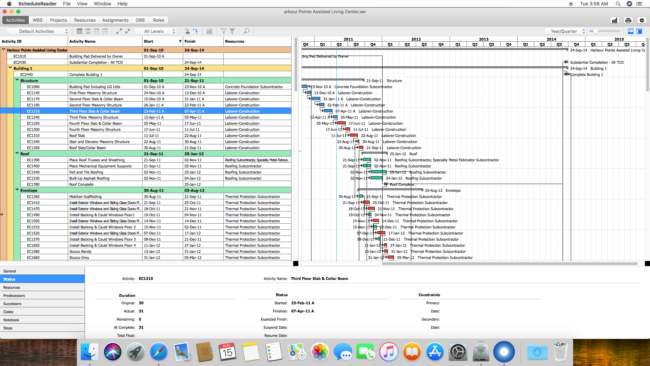As we step into 2024, the construction industry continues with its dynamic evolution. The year holds great promise for the construction industry, as it continues to navigate through a landscape of rapid technological advancements, evolving project management practices, and a renewed focus on sustainability and innovation. With the global economy showing signs of recovery from the recent challenges, the construction sector is ready for growth and transformation, aiming to avoid any further delays.
In the past several years, the construction industry witnessed a significant shift towards digitalization, with a growing reliance on advanced technologies, such as Building Information Modeling, drones, and project management software. The digital transformation has not only improved project efficiency and accuracy, but has also paved the way for new methods of collaboration and communication between project teams.

2023 was a year of significant progress in construction project management, marked by a growing reliance on technology to streamline processes and improve efficiency. As we look into the new year, we anticipate an acceleration of this trend, with an even greater focus on leveraging digital tools for enhanced project controls, remote collaboration, as well as data-driven decision-making. Determining the upcoming trends will help us to better adjust to them in the upcoming period, and by further discussing them, we will provide insights on how to efficiently employ them into your everyday operations.
Digitalization of Information and Processes
There is a major shift in construction project management towards digitalization, which is transforming how construction information is managed and processed. With a move away from the traditional paper-based workflows and documentation, construction teams are embracing the digital platforms for planning, documentation, reporting, and overall decision-making.
One of the key aspects of the digitalization in construction project management is the adoption of digital tools and technologies that streamline information management. One of the prime examples of digitalization in construction is Building Information Modeling, or BIM – a software that centralizes data in a digital format, thus enhancing collaboration among project stakeholders and facilitates better decision-making throughout the project’s lifecycle.

Another aspect of digitalization is the automation of manual processes with the use of construction management software solutions. These solutions automate tasks, reducing the reliance on paperwork and manual data entry. Project management software not only saves time for construction project management teams, but it also minimizes the risk of errors and ensures that the project information is always up-to-date and easily accessible to all team members.
Sustainability is also one of the key goals not only of the construction project management, but of the whole industry overall. The usage of sustainable and green materials, while also trying to spend as few resources as possible in the project processes has been made much more possible with the digitalization of the project management – the information is now available in digital form, reducing the need for endless piles of printed paper documents.
Remote Work and Electronic Communication
What started as a trend in 2020, is here to stay – the trend towards remote working and electronic communication is reshaping how construction teams collaborate. Virtual meetings and mobile communication tools are now part of the “new normal” and becoming an indispensable tool for seamless remote work in construction.
This also opened a whole new world of opportunities: project managers do not have to be on the construction site all the time – they can follow the project progress and get the latest updates from anywhere in the world. It also diversified the teams’ canvas – with construction project management that is now digital, talent from all over the world can be acquired to work on a particular construction project, without ever leaving their home base.
Increased Use of Mobile Devices and Applications
There is a surge in the use of diverse applications across all levels of construction project teams. Previously mostly used only by project management teams, they are now widely introduced to all team levels. From workers on the site, to project leads, the introduction of user-friendly applications is enhancing communication, collaboration, and productivity on construction sites.
One of the main benefits of mobile devices in construction project management is the ability to access real-time project data from anywhere. Project managers and schedulers, engineers, project controls, and workers on site can use applications on their tablets and phones to view project plans, update progress reports, communicate with team members, and access relevant documentation on the go.

The use of various applications in construction project management is a trend that is here to stay – they offer custom functionalities for different aspects of project planning and execution. There are applications dedicated to project scheduling, budget tracking, resource management, safety compliance, quality controls, and many more aspects. One of the greatest perks of these applications is that they can often integrate with project management software, allowing for seamless data sharing and collaboration across different channels.
Using Software for Scope Tracking
One of the biggest shifts in construction project management, that started several years ago, and keeps developing now more than ever, is the increased usage of software for projects’ scope tracking. Project managers can now create project plans and share them with the team, while tracking the project scope throughout the entire process, and making adjustments and modifications along the way.

Gantt portion in Primavera P6
The industry is increasingly turning to specialized software solutions for accurate and real-time scope tracking. These tools enable teams to also monitor project scope changes, identify potential risks, and maintain alignment with project objectives. Such tool is Primavera P6. It is a powerful project management software widely used in the construction industry for its robust features that enable effective planning, scheduling, management, and assessment. When it comes to scope tracking in construction projects, Primavera P6 offers various functionalities that make it a valuable tool for project managers and teams:
- Comprehensive Work Breakdown Structure (WBS) that can break the project into smaller, more manageable components;
- Scope Baseline Management, which is a reference point for comparing actual project performance against the planned scope;
- Integrated Change Management capabilities that handle scope changes efficiently;
- Real-time tracking of project progress against the planned scope;
- Resource Allocation and Management.
Project Controls Software
The adoption of project controls software is also on the rise, empowering construction project teams to manage costs, schedules, and resources more effectively. These tools provide comprehensive insights into project performance, allowing for proactive adjustments on the go, in order to optimize project outcomes.
The project controls software developed a lot through the years. It allows control of the project plan both visually and through numbers. One of the most popular project controls software in construction project management is ScheduleReader. It is a powerful tool that offers a wide range of possibilities for construction professionals, including project managers, schedulers, project controls, and other project stakeholders.
ScheduleReader’s ability to read, analyze and visualize XER and XML project files created in Primavera P6 allows users to gain a comprehensive view of project schedules, including critical paths, dependencies, and resource allocations, enabling them to make informed decisions about project timelines and resource utilization, and avoiding cost overruns.

Activities View with Gantt Chart in ScheduleReader for macOS
Another notable feature of ScheduleReader is its support for schedule comparison – up to five different versions of project schedules can be compared, enabling construction project managers to identify changes, analyze the impact of these changes on project timelines, and assess project risks. Additionally, ScheduleReader offers robust reporting tools that enable users to generate custom reports and share project data with relevant stakeholders, which facilitates transparent communication and collaboration across construction project teams.
ScheduleReader is available in Standard and PRO version and is also available for macOS. You can download a free 15-day trial to discover how it can bring your construction project management to the next level.
Read our PCPM Construction Case Study here, and find out how ScheduleReader helps construction management teams to get an effective project communication flow and increase their efficiency.
The Road Ahead: Navigating Construction Project Management in 2024
The expectations for 2024 are high, with industry experts anticipating continued growth in construction activity, driven by infrastructure development, residential and commercial projects, and a renewed emphasis on sustainability. As the project teams, as well as the overall construction companies adapt to the new market demands and technological innovations, the industry is set to undergo further changes that will shape its future trajectory.

In this dynamic environment, construction companies are reevaluating their strategies, embracing new technologies, and focusing on enhancing project management practices to stay competitive. From rethinking traditional construction methods, up to adopting innovative project management tools, the industry is on a path of transformation that promises to redefine how the projects are created, planned, executed, and evaluated.

